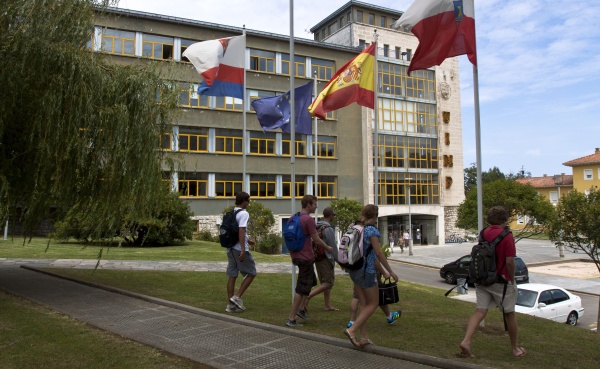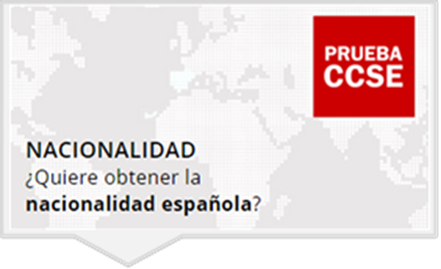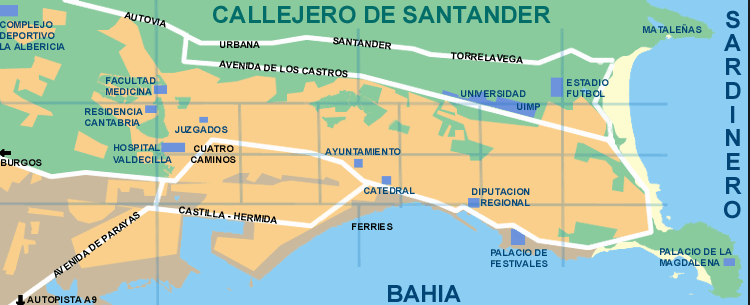Constitutional test Sociocultural Knowledge and Spain (CCSE)
Instituto Cervantes test for obtaining Spanish nationality (CCSE)
 |
|
General Information
What is the CCSE test?
The constitutional and sociocultural knowledge of Spain test (CCSE test) is an exam, prepared by the Instituto Cervantes, which uses a variety of tasks to evaluates candidates’ knowledge of the Spanish Constitution and Spain’s social and cultural reality. It is one of the requirements established by law for granting Spanish nationality to Sephardim originally from Spain, and for residents in Spain to acquire Spanish nationality as appropriate.
Who is the test intended for?
The CCSE test is intended for any people who wish to obtain Spanish nationality. Candidates of any nationality aged 18 and over and with legal capacity to contract can register to sit the CCSE tests.
Exemptions and Dispensations
- For the purposes of the process of obtaining Spanish nationality, minors and people whose legal capacity has been modified by the courts are exempt from taking the constitutional and sociocultural knowledge of Spain test.
- Illiterate people, people with learning difficulties and people who were educated in Spain and have successfully completed compulsory secondary education (ESO) can be given dispensation.
2017 CCSE calendar and exam dates
|
EXAMINATION PERIODS |
DATE OF EXAM |
ENROLMENT END DATE |
|
January 2017 |
Thursday, 26 January |
Thursday, 5 January |
|
February 2017 |
Thursday, 23 February |
Thursday, 2 February |
|
March 2017 |
Thursday, 30 March |
Thursday, 9 March |
|
April 2017 |
Thursday, 27 April |
Thursday, 6 April |
|
May 2017 |
Thursday, 25 May |
Thursday, 4 May |
|
June 2017 |
Thursday, 29 June |
Thursday, 8 June |
|
July 2017 |
Thursday, 27July |
Thursday, 6 July |
|
September 2017 |
Thursday, 28 September |
Thursday, 7 September |
|
October 2017 |
Thursday, 26 October |
Thursday, 5 October |
|
November 2017 |
Thursday, 30 November |
Thursday, 9 November |
How to enrol?
Enrolling and the corresponding payment for the CCSE test must be done online, after registering, in the private user area of the official website of the Instituto Cervantes for the CCSE tests.
1. Visit the page: https://examenes.cervantes.es/
2. Then click on “CCSE test”:

3. You must register as a new user. If you have already registered, you can access the application with your username and password:

4. Once you have registered, you will receive an email with a link to start the session. This link will direct you to a page where you can set your password.
5. After setting your password, you can start the session by clicking on new enrolment.

(In future, you can start a session by identifying yourself at http://examenes.cervantes.es/ using the username and password with which you registered).
6. You must then carry out the 3 steps necessary to complete the enrolment.
Step 1 – Select exam centre and date
Select the exam centre and the date you want for sitting the exam.
Once you have clicked on search, the centre(s) that meet the search criteria will appear.
Next, select the ENROL option for the corresponding centre.
Step 2 – User´s enrolment details
Check your enrolment details before continuing with the process.
Step 3 – Payment
Payment is done online.
You can select one of the following suggested payment methods: PayPal, Visa or MasterCard.
7. When the process is complete, you can print a receipt for the enrolment in the “MY ENROLMENTS” section.
8. A few days before the start of the course you will receive an email with the official call for the exam which will list the place, date and time of the test
CCSE test at the UIMP
The Las Llamas Campus, the Santander location of the UIMP (Universidad Internacional Menéndez Pelayo), is a certified centre for taking the CCSE test.
If you want to sit the test in our centre, you can register through the link:
Registration for the CCSE-UIMP test
How much does the CCSE test cost?
- Enrolling for the CCSE test in 2017 costs 85 €uros. This price includes examination fees, issuing the qualification certificate and access to all of the preparation materials, including the handbook for preparing for the CCSE test.
- Enrolling for the CCSE test entitles a candidate to sit it on a maximum of two occasions if a candidate does not pass it on the first attempt or does not sit it at the first call. In this case, the candidate must attend the second call in the same exam centre where he/she sat the first. There is a maximum period of 18 months from the date the exam was first sat.
Publishing results
- The results will be published about 20 days after the test.
- Candidates can consult their results electronically in their private space on the CCSE portal, using the personal access details (username and password) they provided when they registered.
- In this private space, the electronic qualification certificate, electronically signed by the Instituto Cervantes, can be downloaded at any time. The certificate has a Secure Verification Code (CSV) that makes it possible to verify the authenticity of the paper copy.
Support materials available
The Instituto Cervantes provides candidates with a range of free materials for preparing for the test. These are listed below.
Download related files
- Specifications for the CCSE test
- List of contents
- CCSE sample test paper
- Preparation handbook for the CCSE test
- Multilingual glossary
Questions
Almost all questions can be answered by reading the information available from the website: https://ccse.cervantes.es
Instituto Cervantes information e-mail: This email address is being protected from spambots. You need JavaScript enabled to view it.
Information
|
For any clarification or additional information, you can contact our centre´s Student Registry at the address provided below: |
||
|
Secretaría de Alumnos |
||
|
Universidad Internacional Menéndez Pelayo |
Teléfono: +34 942 29 87 00 |
|
|
(Campus de las Llamas) |
||
|
Avda. de los Castros, 42 |
This email address is being protected from spambots. You need JavaScript enabled to view it.This email address is being protected from spambots. You need JavaScript enabled to view it. |
|
|
39005 – Santander |
||


